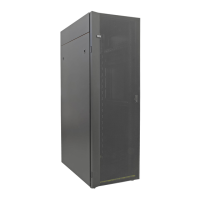installation. The Type 7965 rack has sufcient clearance underneath the rack to enable the quick
connects to be run underneath the rack. This provides a very clean hose-routing solution with hoses of
minimum length.
Note: Each hose must be routed with a minimum bend radius of 200 mm (8 in.). A bend radius less than
200 mm (8 in.) will cause the hose to kink, will restrict the flow of water to and from the heat exchanger,
and will void the heat exchanger warranty.
If the hoses must be run overhead, either route the hoses through the rack vertically, or route them
vertically down the hinge (pivot) side of the heat exchanger, leaving enough slack in the hoses to reach
the couplings.
After several hours of operation, repeat the air-purging procedure on the valve (trapped air from the
hoses might have migrated to the heat exchanger).
Check the heat exchanger for air in the manifolds again after one month of operation, to be sure that the
heat exchanger is lled correctly.
Water cooling system specication and requirements
Learn about the specic water treatment procedures and requirements that are needed for situations
where the facilities water system (FWS) water or the technology cooling system (TCS) water can be used
to directly cool the datacom equipment.
Overview
The datacom equipment cooling system (DECS) is a water loop in which the water comes in contact with
the components to be cooled. There are cases where the DECS water is supplied by an in-rack CDU or can
be supplied by an external CDU that service multiple racks. For details of potential liquid cooling systems
and loops within a data center and the terminology that is used, see Figure 116 on page 160
.
The water quality standards that are specied pertain only to the DECS water loop that comes into
contact with compute components. The ongoing monitoring and maintenance procedures are also
described.
The cooling loop hardware consists mainly of corrosion resistant alloys, such as copper alloys and
stainless steels. EPDM rubber must form the inner lining of all the hoses in the system. The chemistry of
the cooling water must be properly maintained to avoid system disruption or shutdown due to any of the
four common water-related problems of corrosion, microbiological growth, scale formation, and fouling.
The details of the water treatment depend on whether the local municipality allows the disposal of water
that contains some cleaning chemicals down a sanitary drain. If the local municipality does not allow the
disposal of contaminated water down a sanitary drain, a deionizing bypass can be included in the water
cooling loop to allow the cleaning of the water to purity levels corresponding to resistivity > 0.1 MΩ.cm
(conductivity < 10 μS/cm) before pouring the water down the drain. You are responsible for verifying the
local regulations before you dispose any water.
Racks and rack features
159

